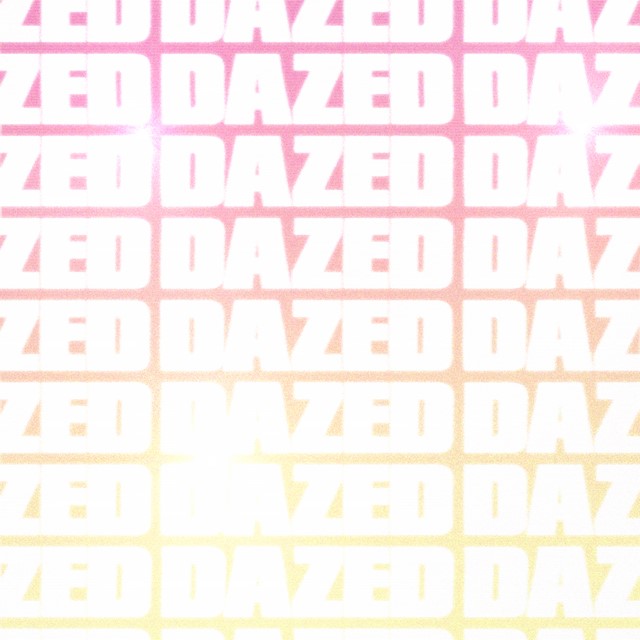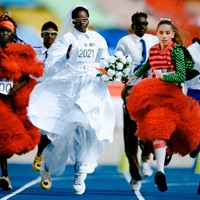See-through jeans, hi-vis vests, and THAT Joey Tribbiani look: fashion is creating garments designed to go viral
At the end of August, fast fashion brand Pretty Little Thing released a ‘statement’ fluorescent yellow hi-vis jacket, complete with reflective strips. The internet reacted accordingly and criticism rolled in as Twitter at large wondered how a building site staple went fashion, while the likes of The Independent, The Daily Mail, The Sun, and Cosmopolitan all covered the unfolding ridicule. Even Screwfix got involved with an Instagram post that racked up 1600 likes, eclipsing their usual sub-200 offerings. And yet, within days of its release, the offending jacket had sold out in every size.
While the majority of the UK seemingly wasn’t mentally prepped for high vis, Pretty Little Thing actually did nothing more than tap into a trend that’s been bubbling under for seasons. Back in 2016, Kanye West sent the meme machine into overdrive as he visited a glacier looking fresh off a shift on the M6, while Moschino sent its hi-vis SS16 collection down a catwalk flanked by road signs. Soon after, SS17 saw hi-vis further infiltrate high fashion, as Heron Preston and UPWW collaborated with the New York Department of Sanitation and Utility Pro respectively, and at Calvin Klein, Raf Simons took the trend head-to-toe for AW18. The look wasn’t subtle and nor was the fast fashion interpretation of it.
“The entire internet slating your latest product drop might sound like a recipe for a hastily called PR strategy meeting, but, actually, it’s becoming the bread and butter of fashion marketing”
It doesn’t stop there, though. From denim thongs to see-through jeans, high street and e-comm brands aren’t just ‘borrowing’ design cues from high fashion anymore, they’re following their lead in playing the social media game and leaning into reaction journalism. The entire internet slating your latest product drop might sound like a recipe for a hastily called PR strategy meeting, but, actually, it’s becoming the bread and butter of fashion marketing.
Demna Gvasalia, in particular, knows the power of a viral garment and has understood the power of fashion as meme since day one. Balenciaga’s ultra layered AW18 looks were parodied via the now-famous ‘Could I be wearing anymore clothes?’ Joey Tribbiani meme, created by the likes of @hey_reilly and @siduations, and doubtlessly shared in every fashion-aligned group chat across the globe. Fast forward to the coats actually going on sale (for just over £6,000...) and the Joey meme is working its magic again, sparking its own Twitter Moment and garnering coverage from the likes of Elle, GQ, Time and Harper’s Bazaar.
The brand’s AW18 t-shirt shirt also caused a stir, with people making their own versions and the Guardian, Refinery29 and Esquire jumping on the story. Not to mention the £1705 Ikea-inspired bag, the stacked platform Crocs and, most recently, the Spiderman dress released by Gvasalia’s own label, Vetements.
The fashion that sparks memes is generally accepted as either a kind of visual joke or just flat out terrible. And the reactions online reflect that. Last year’s spate of viral jeans, for example – button-offs, suspenders and see through iterations from Y/Project, Carmar Denim, Topshop, ASOS and repeat offenders Pretty Little Thing - was met with a decisive ‘U OK hun?’ from the masses.
So why haven’t these brands drowned in criticism? And why is the high street so dedicatedly emulating looks which have been resoundingly ridiculed?
It goes back to the old adage that “any press is good press,” says Sophie Green, PR and Communications Manager at BrandAlley. “There’s a tried and tested practise in the industry of designing pieces specifically for press. They tend to be produced in small runs as they are less likely to appeal to the end consumer but they do place fantastically in the pages of magazines. Product designed with virality in mind feels like an extension of this strategy in many respects.”
Brands pushing the boundaries of taste and designing clothes to spark debate is nothing new. What is new is the publications desperate to fill daily content calendars with every viral moment, as well as the access the general public has to the fashion industry. Almost anyone can watch the shows in real time and see garments that buyers of old wouldn’t have touched.
While McQueen or Galliano’s catwalk antics enraptured fashion insiders, they most likely passed your average person by. But in the age of the internet, fashion’s contentious talking points are just as likely to be shared by your old school mate as they are fashion editors. A viral hit provides easy access to new audiences, and that’s exactly what brands such as Balenciaga and Y/Project are betting on.
“Selling of the product is the key objective, but must come secondary to how it is made to go viral,” explains Sophie Johnson, lecturer in Fashion Business and Promotion at Birmingham City University. “A great outcome of successful viral marketing is new consumers and audience.”
Eleanor Snare, a freelance marketing consultant expands on that point: “Raising awareness is the first stage in the consumer funnel. The original version is known by the acronym AIDA, which stands for Awareness, Interest, Desire, Action. The more people who are aware of your brand, the more people get pulled into that funnel and might eventually buy from you.” Snare cites Burberry’s teen-centric influencer marketing as a golden example of bagging future customers while still selling to your existing market. “Do we really think the people sharing a meme of that crazy Balenciaga coat are the same people buying from Balenciaga each season? A brand can market to and actually sell to very different audiences,” she says.
“Where once we would see highly diluted representations of catwalk looks on the high street, fast fashion brands have switched on to both the power of a divisive release and their customers’ desire for directional pieces”
High-end labels aren’t necessarily selling to the people who are sharing screenshots of their clothes with the cry-laughing emoji, they’re playing the long game. But the high street, with its accessible price points, is. For every person sharing for likes, there’s another taking the opportunity to buy into a high fashion trend for an affordable price – although often at an ethical cost.
Where once we would see highly diluted representations of catwalk looks on the high street, fast fashion brands have switched on to both the power of a divisive release and their customers’ desire for directional pieces. As each one sells out, and as each new weird item racks up shares, brands will continue to lay down the gauntlet for the next viral hit. The brands that become memes are not the butt of the joke. They wrote it.




